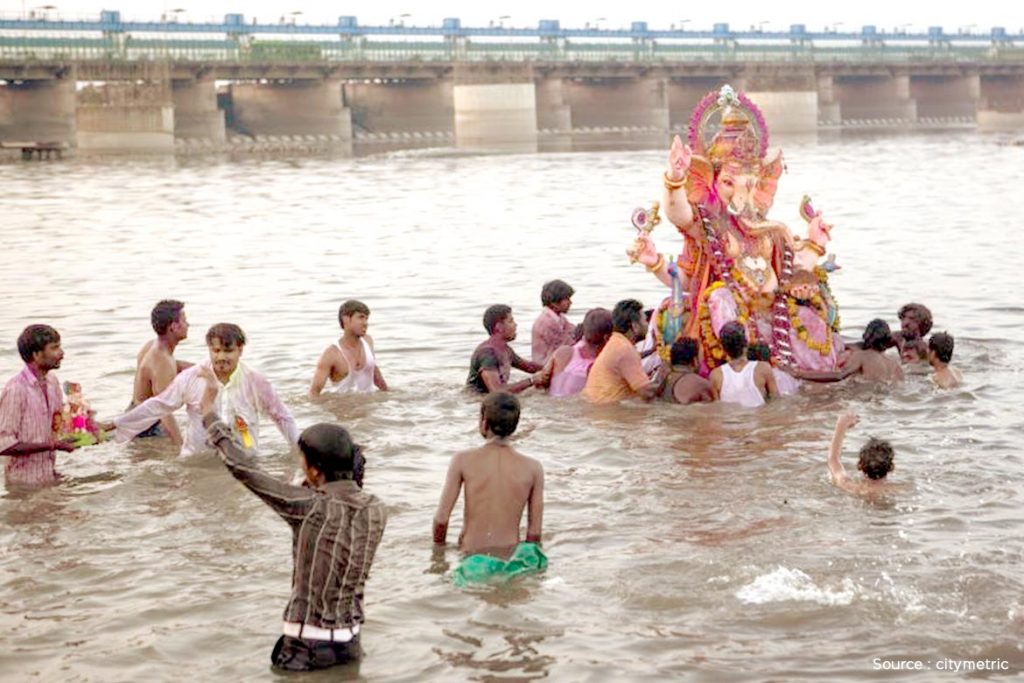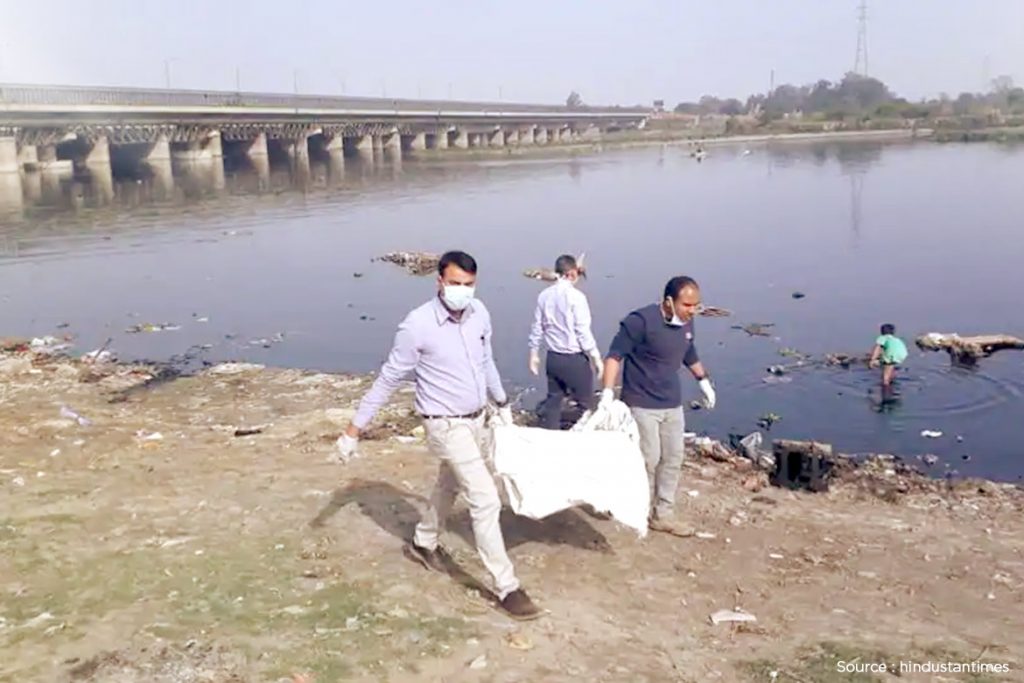We are living in a country, which is blessed with a number of rivers and their multiple tributaries. These rivers are classified into the Indus River system, the Brahmaputra River system, the Ganges River system, the Peninsular river system, and the Aravali range River system. Another method of classifying rivers is based on their mouth, either river is draining into the Arabian sea or into the Bay of Bengal. All major rivers of India are originated from the Himalayan or Karakorum range, Aravali range, Western Ghats or Sahyadri range and Vindhya and Satpura range. In a nutshell, it can be said that we live in a land of water, India has more water than it requires. But the increasing water pollution made this river unhealthy and unfit for use. Today, in this article we will look at the current condition of rivers in India.
Major Polluted Rivers
Ganges
Ganga is the longest and holiest river of India it originates in Uttarakhand and ends in West Bengal. More than five crore people live along its bank. The quality of water is degrading day by day, recently Central Pollution Control Board declared the water of river Ganges unfit for human bathing. It is the sixth most polluted river in the world. The river flows through more than 200 cities and it is dumped with tonnes of human waste. Sewage and industrial effluents are the major cause of its pollution. A religious bath is also a major factor for the pollution of river Ganges, more than 70 million people take a holy dip in this river on multiple occasions.
Yamuna
This river is a second-longest tributary of Ganga and it meets Ganga at Prayagraj. During its course, this river flows through the national capital region and it is where it gets most polluted. This river became the most polluted river in the country, the water near Delhi is almost black in color. Last year in November a toxic froth was generated in the river and covered the surface of the Yamuna near Kalindi Kunj area of Delhi. The main reason for the pollution of the Yamuna in Delhi is near stagnant water and high dumping of industrial waste. Biological oxygen demand is constantly increasing in this river and many times a large number of dead marine animals can be found on its surface.
Cauvery
The river originates in Tamil Nadu is also battling with pollution. Earlier it was a perennial river, now at many places, it became a sand sea. The major dams across the river are filled with very less amount of water which nearby area a water-deficit region. The main reason for drying for this river is the intense construction work along both sides of the river. Not only the level of water is decreasing but also there is a drastic increase in coliform bacteria level in the river.
Gomti
This River was once a lifeline of Lucknow, is now almost a dead river. The marine life of this river is destroyed completely. Huge Chunks of garbage can be spotted throughout the course of Gomti, this hinders the natural flow of the river.
Cooum
This river of Chennai now became of floating garbage can, with as much as one lakh tone waste dumped in it, the river was once a major water source for the city.
Ulhas
This is a major source of water for people of Thane, Maharashtra, but this river is dying now, it turned green in color and is full of foul smell. This river is called as Nala (drain) by local people.
Sabarmati
According to the Central Pollution Control Board, this was the third most polluted river of the country, this river flows through Rajasthan and Gujarat.
Mithi
This river flows through the island city of Mumbai. In 2018, it became the most polluted river particularly in a stretch of 18 kilometre in Mumbai. It contained 15 times more human and animal excreta than the safe limit.
Reasons for Pollution

Discharge of untreated sewage is the single most important source of river pollution in India. There are no proper Sewage Treatment Plants (STPs) are installed and major drains are directly dumped into rivers. On top of that the presents Sewage Treatment Plants are not functioning completely. This increasing dumping of waste sewage increases the Biological Oxygen Demand of the rivers. The Biological Oxygen Demand levels near major cities crossed 20mg O/L, which is a sign of danger for the marine biodiversity of the river. The coliform bacteria level is also drastically rising in most of the rivers, ideally, there should be no coliform bacteria present in water, even if it is present the accepted mark is 104 MPN/100ml, but many rivers cross to the mark of 500MPN/ 100ml, which signifies the fact that these rivers are not even fit for nondrinking purpose.
Minerals and natural gas exploration is another big threat to these rivers. Many Oil companies get riverbed in auction for exploration of petroleum and gas these activities affect the river health to a great extent.
Industrial effluents are the most poisonous substances dumped in rivers, this effluent not only pollute the river water but also make it venomous, near the dumping site of these industries a large number of dead fishes can be spotted. Despite multiple warnings by Pollution Control Boards and Green Tribunal, these industries continued the discharge of industrial waste into rivers.
Sand mining is also responsible for the river health, reckless dredging of sand from riverbed disturb the natural course of the river and also the pollution generated by dredgers contributes to the deterioration of river health.
Religious beliefs of people to some extent deteriorate the river water, crores of people take holy bath in rivers this makes river water polluted also the cremation along the bank of rivers pollute the river water. On many festivals Idol immersion by devotees also poses a great threat to the river ecosystem.
Also Read: Life in Kashmir after Abrogation of Article 370
How it Affects Us?
Increasing pollution in rivers is affecting ecology and biodiversity astronomically. River contamination threatens biospheres and wildlife sanctuaries. Most of the migratory species are now becoming extinct due to the loss of water and nesting sites. The polluted and decreasing water in rivers lead to less loss of habitat for many marine animals.
When the Marine biodiversity gets to be affected it will lead to the loss of livelihood of many fishermen because in the fishing sector India is mainly dependent on inland fishing, not only it will hamper the interest of Indian fishermen but also it will be detrimental to the export of fishery. Also, there will be shortage of drinking water, as these rivers are the major source of freshwater and if a person consumes this polluted water it will bring a great burden of waterborne disease which India is already facing, one-third deaths due to disease in India are because of water and foodborne diseases, this, in turn, will hamper the economy of the nation.
Steps Taken by the Government

The Central Pollution Control Board (CPCB) in association with State Pollution Control Boards (SPCBs) / Pollution Control Committees(PPCs) is monitoring the quality of water bodies at 2500 locations across the country under National Water Quality Monitoring Programme (NWQMP) which indicate that organic pollution is the predominant cause of water pollution. According to PIB following steps have been taken by the government to control water pollution.
- Preparation of action plan for sewage management and restoration of water quality in aquatic resources by State Governments.
- Installation of an Online Effluent Monitoring System to check the discharge of effluent directly into the rivers and water bodies.
- Setting up of monitoring network for assessment of water quality.
- Action to comply with effluent standards is taken by SPCBs / PCCs to improve the water quality of the rivers.
- Financial assistance for installation of Common Effluent Treatment Plants for a cluster of Small Scale Industrial units.
- Issuance of directions for implementation of Zero Liquid Discharge.
- Issuance of directions under Section 5 of Environment (Protection) Act, 1986 to industries and under Section 18(1)(b) of Water (Prevention and Control of Pollution) Act, 1974.
- Implementation of National Lake Conservation Plan (NLCP) and National Wetland Conservation Programme (NWCP) for conservation and management of identified lakes and wetlands in the country which have been merged in February 2013 into an integrated scheme of National Plan for Conservation of Aquatic Eco-systems (NPCA) to undertake various conservation activities including interception, diversion and treatment of wastewater, pollution abatement, lake beautification, biodiversity conservation, education and awareness creation, community participation, etc.
